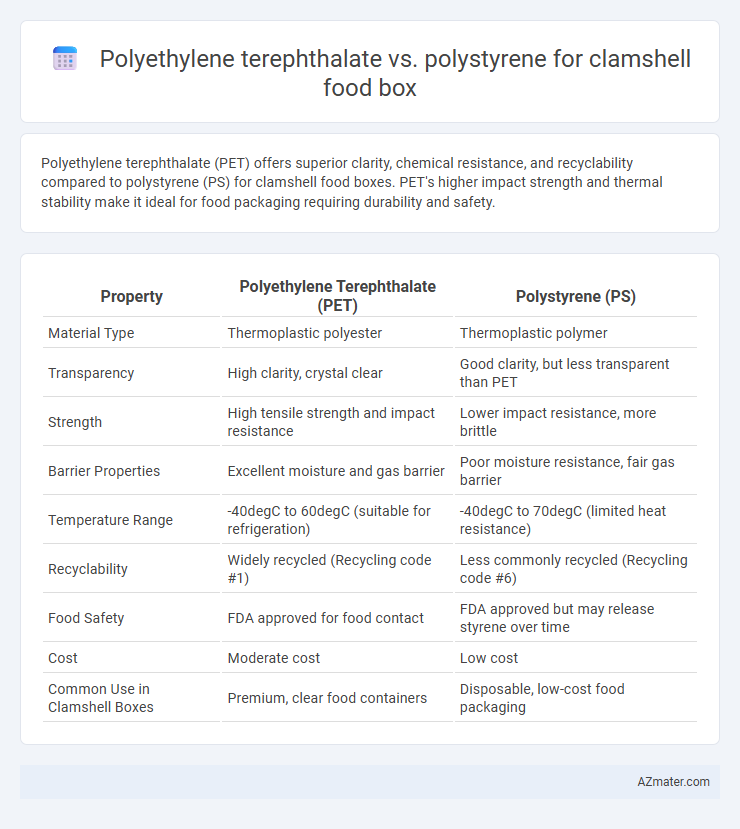Polyethylene terephthalate (PET) offers superior clarity, chemical resistance, and recyclability compared to polystyrene (PS) for clamshell food boxes. PET's higher impact strength and thermal stability make it ideal for food packaging requiring durability and safety.
Table of Comparison
| Property | Polyethylene Terephthalate (PET) | Polystyrene (PS) |
|---|---|---|
| Material Type | Thermoplastic polyester | Thermoplastic polymer |
| Transparency | High clarity, crystal clear | Good clarity, but less transparent than PET |
| Strength | High tensile strength and impact resistance | Lower impact resistance, more brittle |
| Barrier Properties | Excellent moisture and gas barrier | Poor moisture resistance, fair gas barrier |
| Temperature Range | -40degC to 60degC (suitable for refrigeration) | -40degC to 70degC (limited heat resistance) |
| Recyclability | Widely recycled (Recycling code #1) | Less commonly recycled (Recycling code #6) |
| Food Safety | FDA approved for food contact | FDA approved but may release styrene over time |
| Cost | Moderate cost | Low cost |
| Common Use in Clamshell Boxes | Premium, clear food containers | Disposable, low-cost food packaging |
Introduction to Clamshell Food Packaging
Clamshell food packaging offers a convenient, secure solution for transporting and displaying fresh food products, with materials like Polyethylene Terephthalate (PET) and Polystyrene (PS) playing critical roles. PET clamshells provide excellent clarity, durability, and recyclability, making them ideal for preserving food freshness while supporting sustainability efforts. Polystyrene clamshells are lightweight and cost-effective but may lack the environmental benefits and clarity found in PET, influencing their suitability based on specific packaging needs.
Overview of Polyethylene Terephthalate (PET)
Polyethylene terephthalate (PET) is a widely used thermoplastic polymer known for its excellent clarity, high strength, and superior barrier properties against moisture and gases, making it ideal for clamshell food boxes. PET's recyclability and resistance to impact and chemicals offer significant advantages in food packaging sustainability and safety. This material maintains food freshness longer and supports convenience through its lightweight yet durable structure, outperforming many alternatives in the market.
Overview of Polystyrene (PS)
Polystyrene (PS) is a versatile thermoplastic polymer widely used for clamshell food containers due to its excellent clarity, rigidity, and cost-effectiveness. Its low weight and good insulating properties make PS ideal for packaging perishable items, although it is less resistant to heat and chemical exposure compared to Polyethylene terephthalate (PET). Polystyrene is favored for single-use applications where affordability and product visibility are critical, despite environmental concerns related to its limited recyclability.
Material Properties: PET vs. PS
Polyethylene terephthalate (PET) offers superior clarity, impact resistance, and chemical stability compared to Polystyrene (PS), making it ideal for clamshell food boxes that require durability and visually appealing presentation. PET exhibits higher tensile strength and better resistance to heat, allowing for safer use in microwave and freezer conditions, whereas PS tends to be more brittle and less heat tolerant. The barrier properties of PET also provide enhanced protection against moisture and oxygen, extending the shelf life of food products better than PS.
Food Safety and Chemical Resistance
Polyethylene terephthalate (PET) offers superior food safety due to its high chemical resistance and low risk of leaching harmful substances, making it ideal for clamshell food boxes. Polystyrene (PS), while offering good structural strength, tends to have lower chemical resistance and potential to release styrene compounds, raising food safety concerns, especially with hot or acidic foods. PET's recyclability and transparency also contribute to its preference in food packaging applications where maintaining food integrity is critical.
Environmental Impact and Recyclability
Polyethylene terephthalate (PET) clamshell food boxes exhibit higher recyclability rates and lower environmental impact due to their widespread acceptance in recycling programs and ability to be remelted without significant degradation. Polystyrene (PS) clamshells, often labeled as #6 plastic, face challenges in recycling because of limited facilities and their tendency to release toxic styrene compounds when not properly processed. The environmental footprint of PET is lower than PS, given PET's reduced carbon emissions during production and enhanced potential for circular reuse, making PET a more sustainable choice for food packaging.
Durability and Performance in Use
Polyethylene terephthalate (PET) offers superior durability for clamshell food boxes due to its high tensile strength and resistance to impact and moisture, making it ideal for maintaining food freshness and structural integrity during transport. Polystyrene (PS) is more brittle and prone to cracking under stress, reducing its suitability for repeated use or heavier food items. PET also provides better clarity and chemical resistance, enhancing performance in use where visibility and safe food contact are critical.
Cost Comparison and Market Availability
Polyethylene terephthalate (PET) typically costs more than polystyrene (PS) due to its superior durability and recyclability, making it a preferred option for eco-conscious brands despite the higher price point. Polystyrene remains widely available and less expensive, making it a common choice for budget-sensitive markets and short-term food packaging needs. Market availability for PET is increasing as sustainability regulations tighten, while polystyrene faces declining demand due to environmental concerns and regulatory restrictions.
Consumer and Industry Preferences
Polyethylene terephthalate (PET) is favored in clamshell food boxes for its superior clarity, high strength, and excellent barrier properties, making it ideal for consumers seeking visibility and freshness in food packaging. Polystyrene (PS), while more cost-effective and providing good rigidity, often faces criticism for its environmental impact and limited recyclability, influencing industry shifts toward more sustainable options like PET. Industry trends show increasing preference for PET due to its recyclability and compliance with food safety regulations, meeting consumer demand for eco-friendly and health-conscious packaging solutions.
Conclusion: Choosing the Best Material for Clamshell Food Boxes
Polyethylene terephthalate (PET) offers superior clarity, strength, and recyclability compared to polystyrene (PS), making it a preferred choice for clamshell food boxes requiring durability and environmental sustainability. PS provides cost-effectiveness and good insulation but lacks the mechanical robustness and eco-friendly attributes of PET. Selecting PET ensures better product presentation and aligns with increasing consumer demand for recyclable packaging solutions.

Infographic: Polyethylene terephthalate vs Polystyrene for Clamshell Food Box
 azmater.com
azmater.com